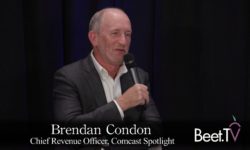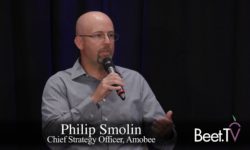In an age of content abundance, gaining cut-through seems harder than ever. So, how should media and entertainment companies best use advertising to drive attention for their new releases?
Over a sustained period, across platforms and using a targeted approach, according to James Rothwell, Comcast VP, Global Agency, Brand & Industry Relations for Comcast Spotlight, which is Comcast Cable’s ad sales unit.
His recommendation is based off a just-released analysis of 36 media and entertainment campaigns that Comcast Spotlight ran in 2018:
1. Sustained exposure:
“A flight of about five to seven weeks really drove conversion rates and ensured that the reach and frequency was was high,” Rothwell tells Beet.TV in this video interview. This particularly benefits episodic content.
2. Multi-platform approach:
“Using both linear and VOD … in concert … enabled viewers to … see the ads multiple times, which again drew more conversion lift.” A campaign spanning 3+ platforms drives significantly higher results than campaigns running on just one or two platforms, according to the research.
3. Mix and match platforms
The combination of those platforms is a significant weighting factor – and choosing distinct platforms can reduce overlap. Comcast recommends choosing one broad-reach platform, one narrow. It has seen that, “by combining linear and VOD, only 29% of reached households were exposed to both platforms, demonstrating the value of multi-platform incremental reach”.
4. Smarter audience segments:
“Ensure that your audience segments are constructed in the right way. In the past, we’ve seen media and entertainment clients just going after the clients that are already loyal. (But) (they) need to find new viewers. (They should) feed the top of the funnel (and) push those new potential viewers down the funnel to convert and tune into the new content.”
This video is part of a series from the Beet Retreat in the City, “We’re Going Local!” hosted by GroupM Worldwide and sponsored by Amobee, Comcast Spotlight, TVSquared and WideOrbit. Please visit this page for additional segments.














































